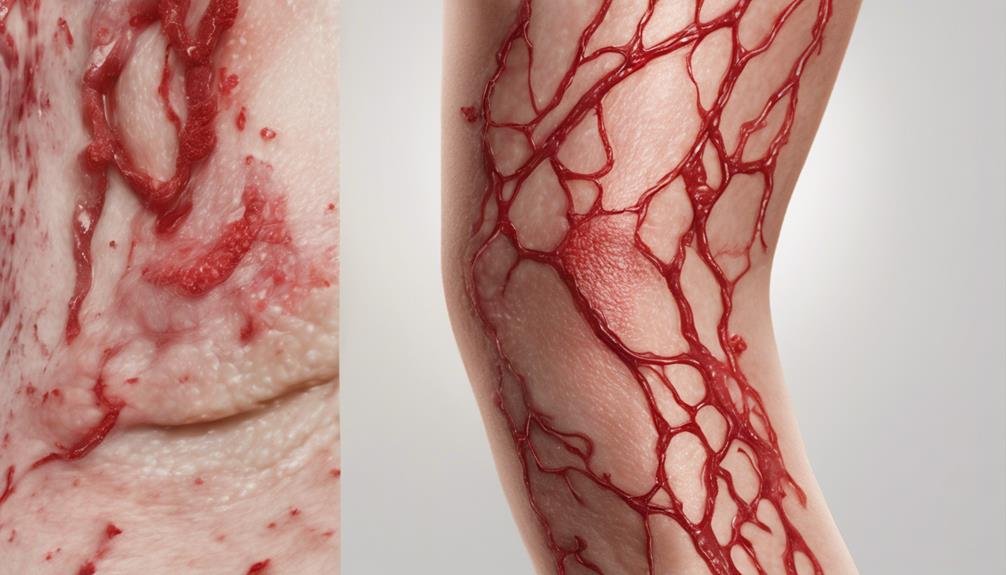To effectively address redness and inflammation, you must first understand the underlying causes and triggers that can exacerbate these skin concerns. By focusing on gentle skincare practices and incorporating soothing ingredients, you can help calm and nurture your skin back to a healthier state. However, there is more to this comprehensive approach than just topical treatments; lifestyle adjustments play a significant role in managing redness and inflammation. Remember, your skin reflects your overall well-being, so taking a holistic approach is key to achieving long-lasting results.
Understanding Redness and Inflammation
To effectively address redness and inflammation, it's crucial to understand the underlying causes and processes that contribute to these skin concerns. Redness and inflammation often stem from a compromised skin barrier, which acts as the first line of defense against external irritants. When the skin barrier is weakened, it becomes more susceptible to inflammation, leading to visible redness and sensitivity.
In combating redness and inflammation, it's essential to look for skincare products with anti-inflammatory properties. These ingredients help to soothe the skin, reduce redness, and calm irritation.
By incorporating products that contain anti-inflammatory agents such as green tea extract, niacinamide, or colloidal oatmeal, you can help restore balance to your skin and alleviate redness effectively.
Understanding the role of the skin barrier and utilizing products with anti-inflammatory properties are key steps in managing redness and inflammation. By nurturing your skin with the right ingredients, you can support its natural healing processes and promote a calmer, more balanced complexion.
Gentle Skincare Routine
Understanding the impact of a gentle skincare routine on managing redness and inflammation is pivotal in achieving skin balance and health. When dealing with redness and inflammation, opting for products with calming ingredients can make a significant difference. These ingredients, such as chamomile, aloe vera, and green tea, have soothing properties that can help reduce irritation and redness.
Moreover, a gentle skincare routine plays a crucial role in maintaining a healthy skin barrier. The skin barrier acts as a protective shield, preventing irritants and allergens from penetrating the skin and causing inflammation. By using gentle products that support the skin barrier, you can enhance its ability to retain moisture and defend against external aggressors.
Therefore, incorporating calming ingredients and focusing on strengthening the skin barrier through a gentle skincare routine can be key steps in reducing redness and inflammation, promoting healthier and more balanced skin.
Cooling and Soothing Ingredients
Cooling and soothing ingredients are essential components in skincare formulations designed to alleviate redness and inflammation. Herbal remedies have long been used for their calming properties in skincare. Ingredients like chamomile, known for its anti-inflammatory effects, can help reduce redness. DIY masks can be a great way to incorporate these soothing ingredients into your routine. Mixing ingredients like aloe vera, cucumber, or oatmeal can create a cooling mask that helps calm irritated skin.
When creating DIY masks, ensure you're using fresh, high-quality ingredients to maximize their effectiveness. Aloe vera, for example, is well-known for its hydrating and soothing properties. Applying a fresh aloe vera mask can help reduce inflammation and redness while providing a refreshing sensation to the skin.
Cucumber slices placed over the eyes can also help reduce puffiness and redness due to their cooling effect. Experiment with different herbal remedies and DIY masks to find what works best for your skin's unique needs.
Lifestyle Adjustments for Skin Health
To promote overall skin health and address redness and inflammation, making lifestyle adjustments can significantly impact your skin's condition. Starting with diet changes, incorporating foods rich in antioxidants such as fruits, vegetables, and omega-3 fatty acids can help reduce inflammation and promote skin healing. Avoiding trigger foods like dairy or high-sugar items can also aid in managing redness.
Additionally, stress management plays a crucial role in skin health. High-stress levels can exacerbate inflammation, so practicing relaxation techniques such as meditation, yoga, or deep breathing exercises can be beneficial.
Ensuring a balanced lifestyle with regular exercise, proper hydration, and sufficient sleep can also contribute to healthier skin. Remember to protect your skin from harsh environmental factors like UV rays by using sunscreen daily. By making these lifestyle adjustments, you can support your skin's natural healing processes and reduce redness and inflammation effectively.
Professional Treatment Options
For effective management of redness and inflammation on your skin, seeking professional treatment options can provide targeted solutions tailored to your specific needs. Professional treatments offer advanced techniques that can effectively address skin concerns. Here are three options to consider:
- Laser Therapy: Laser treatments can target blood vessels causing redness and inflammation, reducing their appearance and promoting overall skin rejuvenation. This non-invasive procedure can help improve skin tone and texture, providing long-lasting results with minimal downtime.
- Chemical Peels: Chemical peels involve applying a chemical solution to the skin to exfoliate and improve its appearance. They can help reduce redness, inflammation, and hyperpigmentation by promoting cell turnover and revealing healthier, more even-toned skin. Different types of chemical peels are available, ranging from superficial to deep, depending on your skin concerns and goals.
- Microdermabrasion: This procedure involves exfoliating the skin with a diamond-tipped tool or crystals to remove the outer layer of dead skin cells. Microdermabrasion can help improve redness, inflammation, and skin texture, revealing smoother and more radiant skin. It's a non-invasive treatment with little to no downtime, making it a convenient option for many individuals seeking to reduce skin redness and inflammation.
Frequently Asked Questions
Can Stress Worsen Redness and Inflammation?
Yes, stress can exacerbate redness and inflammation. Proper stress management techniques, coupled with consistent skin care routines, can help mitigate these effects. Prioritize self-care, mindfulness, and skincare to combat stress-induced skin issues effectively.
Is It Safe to Use Natural Remedies on Inflamed Skin?
Using herbal remedies, like aloe vera, on inflamed skin can be safe. Remember to do a patch test first. These natural options may offer soothing benefits, but consult with a dermatologist for severe or persistent inflammation.
How Long Does It Take for Redness to Fade?
Redness duration varies based on triggers like skin sensitivity and underlying conditions. Typically, redness can fade within hours to a few days. Keeping skin hydrated and protected from irritants can help expedite the process naturally.
Can Certain Foods Trigger Skin Redness?
Certain foods can trigger skin redness due to food allergies or skin sensitivity. It's essential to pay attention to your body's reactions after eating to identify potential triggers. Keeping a food diary can help pinpoint culprits.
Are There Any Specific Exercises That Help Reduce Inflammation in the Skin?
Engage in facial yoga exercises and target acupressure points to help reduce skin inflammation. These practices can promote circulation, relieve tension, and improve overall skin health. Incorporating these techniques into your routine may aid in calming redness and inflammation.
Conclusion
In conclusion, incorporating anti-inflammatory ingredients like green tea extract and niacinamide into your skincare routine can help reduce redness and inflammation. Did you know that studies have shown that chamomile extract can help decrease skin redness by up to 50%? By prioritizing gentle skincare practices, making lifestyle adjustments, and seeking professional treatments when necessary, you can effectively manage redness and inflammation for healthier, happier skin.





